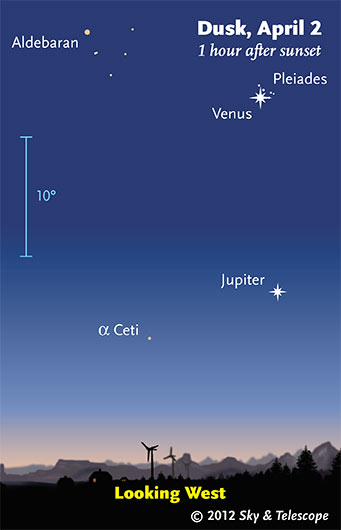
Venus skims the Pleiades on April 2, 3, and 4, while Aldebaran looks on from the side and Jupiter from far below. The blue 10° scale is about the width of your fist held at arm's length.
Sky & Telescope diagram
Friday, March 30
Saturday, March 31
Sunday, April 1
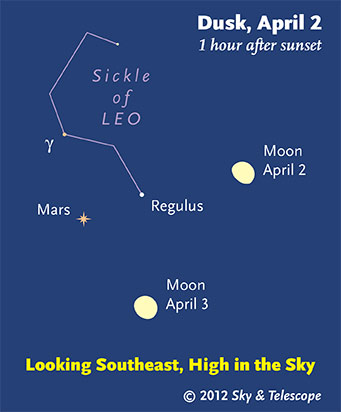
On the other side of the sky, watch the Moon pass icy blue-white Regulus and fiery yellow-orange Mars. (These scenes are drawn for the middle of North America. For clarity, the Moon is shown three times actual size.)
Sky & Telescope diagram
Monday, April 2
Tuesday, April 3
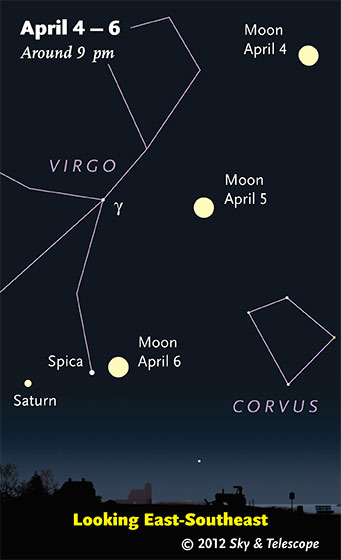
As the Moon becomes full, it approaches Spica and Saturn in the east after dark.
Sky & Telescope diagram
Wednesday, April 4
Thursday, April 5
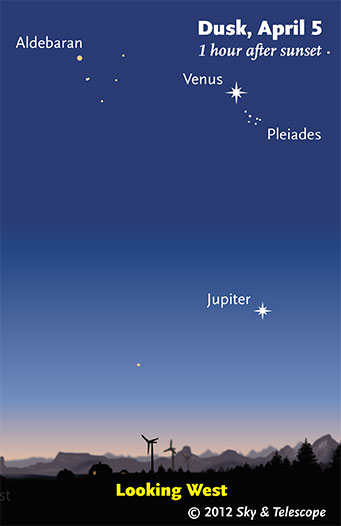
By now the Pleiades are out from under the glare of Venus.
Sky & Telescope diagram
Friday, April 6
Saturday, April 7
Want to become a better amateur astronomer? Learn your way around the constellations. They're the key to locating everything fainter and deeper to hunt with binoculars or a telescope.
For an easy-to-use constellation guide covering the whole evening sky, use the big monthly map in the center of each issue of Sky & Telescope, the essential magazine of astronomy. Or download our free Getting Started in Astronomy booklet (which only has bimonthly maps).
Once you get a telescope, to put it to good use you'll need a detailed, large-scale sky atlas (set of charts). The standards are the little Pocket Sky Atlas, which shows stars to magnitude 7.6; the larger and deeper Sky Atlas 2000.0 (stars to magnitude 8.5); and the even larger Uranometria 2000.0 (stars to magnitude 9.75). And read how to use sky charts effectively.
You'll also want a good deep-sky guidebook, such as Sue French's Deep-Sky Wonders collection (which includes its own charts), Sky Atlas 2000.0 Companion by Strong and Sinnott, the bigger Night Sky Observer's Guide by Kepple and Sanner, or the classic if dated Burnham's Celestial Handbook.
Can a computerized telescope replace charts? I don't think so — not for beginners, anyway, and especially not on mounts and tripods that are less than top-quality mechanically (able to point with better than 0.2° repeatability). As Terence Dickinson and Alan Dyer say in their Backyard Astronomer's Guide, "A full appreciation of the universe cannot come without developing the skills to find things in the sky and understanding how the sky works. This knowledge comes only by spending time under the stars with star maps in hand."
This Week's Planet Roundup
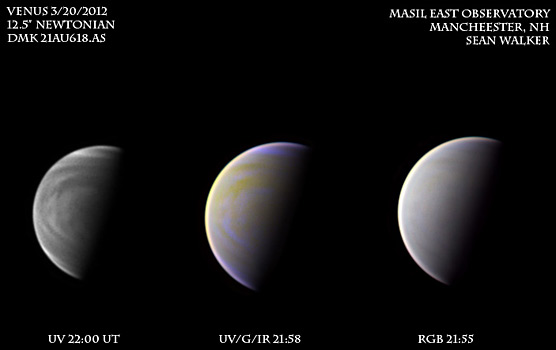
Venus imaged in five colors. To the eye Venus's clouds are almost always pure blank white, but stacked-video imaging can sometimes pull out subtle features. S&T's Sean Walker caught the cloudy planet at dichotomy late on the afternoon of March 20th, imaging with his 12.5-inch reflector through near-ultraviolet (UV), blue (B), green (G), red (R), and near-infrared (IR) filters during excellent seeing.
S&T: Sean Walker
.
Mercury is deep in the glow of sunrise.
Venus and Jupiter are moving ever farther apart in the western twilight, as shown at the top of this page. Venus is the brighter one, on top. Jupiter is 14° below it on March 30th and 19° below it by April 6th. These are the two brightest celestial objects after the Sun and Moon, being magnitudes –4.5 and –2.1 right now, respectively.
Venus skims the little Pleiades star cluster this week. It's closest to the Pleiades' center on April 3rd. Binoculars help show the delicate stars behind Venus's bright glare.
In a telescope, Venus is a little less than half lit and 25 arcseconds tall. Jupiter shows a much lower surface brightness, being farther from the Sun, but its apparent diameter is a little larger: 34″. This is small for Jupiter, and in addition Jupiter is disappointingly fuzzy at its ever-lower altitude.
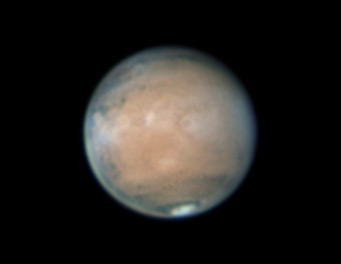
The bland side of Mars was presented to Earth when S&T's Sean Walker took this image on the night of March 20–21. Since then another side has turned our way, when Mars is viewed in the evening hours for eastern North America.
South is up, and celestial east is to the right (the following side; Mars's morning side). Notice the clouds, the much-shrunken North Polar Cap, and the dark collar that has been laid bare around the retreating cap.
S&T: Sean Walker
Mars (magnitude –0.7) shines bright fire-orange under the belly of Leo. Regulus is 5° to Mars's right in the evening, and Gamma Leonis is 7° above it. Mars was at opposition on March 3rd. Now it's fading and shrinking as Earth pulls ahead of it along our faster, inside-track orbit around the Sun. But at least Mars is shining higher in the evening sky now. It's highest in the south by around 10 or 11 p.m. daylight-saving time.
In a telescope Mars is about 12.4 arcseconds wide. Its North Polar Cap has shrunk to become tiny; spring is turning to summer in Mars's northern hemisphere. See our Mars map and observing guide in the April Sky & Telescope, page 50.
Saturn (magnitude +0.3, in Virgo) rises around the end of twilight and glows highest in the south around 1 or 2 a.m. It will come to opposition on April 15th. Shining nearly 6° to Saturn's right is Spica, about half as bright at magnitude +1.0 and bluer. In a telescope Saturn's rings are tilted 14° from our line of sight.
Uranus and Neptune are hidden in the sunrise.
All descriptions that relate to your horizon — including the words up, down, right, and left — are written for the world's mid-northern latitudes. Descriptions that also depend on longitude (mainly Moon positions) are for North America. Eastern Daylight Time (EDT) equals Universal Time (also known as UT, UTC, or GMT) minus 4 hours.
Like This Week's Sky at a Glance? Watch our new weekly SkyWeek TV short. It's also playing on PBS!
To be sure to get the current Sky at a Glance, bookmark this URL:
http://SkyandTelescope.com/observing/ataglance?1=1
If pictures fail to load, refresh the page. If they still fail to load, change the 1 at the end of the URL to any other character and try again.
 0
0
Comments
You must be logged in to post a comment.